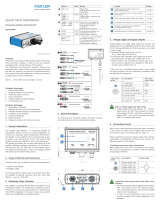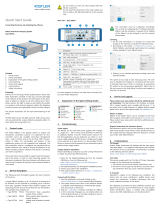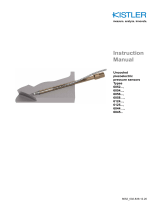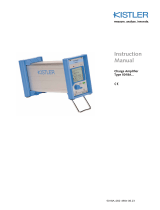Page is loading ...

Instruction
Manual
5064E_002-967e-12.20
Charge Amplier
Type 5064E...


Page 1
5064E_002-967e-12.20
The information in this document is subject to change
without notice. Kistler reserves the right to change or im-
prove its products and make changes in the content without
obligation to notify any person or organization of such
changes or improvements.
© 2020 Kistler Group.
Kistler Group products are protected by various intellectual
property rights. For more details visit www.kistler.com.
The Kistler Group includes Kistler Holding AG and all its
subsidiaries in Europe, Asia, the Americas and Australia.
Kistler Group
Eulachstrasse 22
8408 Winterthur
Switzerland
Tel. +41 52 224 11 11
info@kistler.com
www.kistler.com
Foreword
Foreword

Charge Amplifier Type 5064E...
5064E_002-967e-12.20Page 2
Contents
1. Introduction .................................................................................................................................3
1.1 Disposal instructions for electronic devices ........................................................................4
1.2 Software upgrades and updates .........................................................................................4
2. Safety notes .................................................................................................................................5
2.1 For your safety ....................................................................................................................5
2.2 Notes concerning the product .............................................................................................6
2.3 Electromagnetically compatibility ........................................................................................7
3. Charge amplier Type 5064E1..., 5064E2... ...............................................................................8
3.1 Description Type 5064E1... for SCP Slim & KiBox .............................................................9
3.2 Description Type 5064E2... for SCP ...................................................................................9
3.3 Driftcompensationofthepiezoelectricamplier ..............................................................10
3.3.1 DriftcompensationwithamplierType5064E... .................................................13
3.4 AutomaticsensoridenticationPiezoSmart .....................................................................14
3.4.1 Automatic operating data acquisition ..................................................................16
3.5 pMax value acquisition .....................................................................................................17
3.5.1 ClassicationofpMaxvaluesinTEDS ................................................................19
3.5.2 Analog pMax output ............................................................................................20
3.5.2.1 Analog interface pMax output ..............................................................21
3.5.3 Digital pMax output..............................................................................................22
4. Integration of the SCP/CAN-2 interface for pMax acquisition ..............................................23
4.1 CAN bus network structure ...............................................................................................23
4.2 Connection assignment CAN-2 interface for SCP/SCP Slim............................................24
4.3 Data transmission rate ......................................................................................................25
4.4 CANmessage/CANidentier ...........................................................................................25
4.5 Dataeld ..........................................................................................................................26
4.5.1 DataeldpMaxoutput5064E... ..........................................................................26
4.5.2 Sending test pMax...............................................................................................27
4.5.3 Activation of the CAN-2 output ............................................................................27
4.6 CANdecriptionle(*.dbc) ................................................................................................27
4.7 SCPSoftwaresettingsforparameterizationoftheamplier ............................................28
4.8 ParameterizationforthechargeamplierType5064E ....................................................30
4.9 DigitalI/O(digitalinputsoroutputs) .................................................................................34
4.9.1 Remote function Measure/Reset .........................................................................36
4.9.2 Remotefunctiondriftcompensation(Drco)on/o ...............................................37
5. TEDS conguration...................................................................................................................38
6. Technical data ...........................................................................................................................39
6.1 ChargeamplierType5064E... ........................................................................................39
6.2 BlockdiagramchargeamplierType5064E... .................................................................41
7. Appendix ....................................................................................................................................42
Total pages 43

Introduction
Page 3
5064E_002-967e-12.20
1. Introduction
Thank you for choosing a Kistler quality product. Read
this instruction manual carefully so that you can make full
use of your product's many features.
Where permitted by law, Kistler accepts no liability if this
instruction manual is disregarded or if products other than
those listed under accessories are used.
Kistleroersawiderangeofmeasuringtechnologypro-
ducts and complete solutions:
Piezoelectric sensors for measuring pressure, force,
torque, strain, acceleration, shock and vibration
Strain gauge sensor systems for measuring force and
torque
Piezoresistive pressure sensors and transmitters with
thecorrespondingampliers
Corresponding ampliers (charge ampliers, piezore-
sistive ampliers, etc.), indicators and charge calibra-
tors
Electronic control, monitoring and evaluation units as
wellas application-specicsoftware formeasurement
technology
Datatransmissionmodules(telemetry)
Kistler also designs entire measurement systems for spe-
cicpurposes,forexample,intheautomotiveindustry,in
plastics processing and in biomechanics.
Our complete catalog provides an overview of our product
range. Detailed data sheets are available for nearly all of
our products.
Ifyoustillhaveanyspecicquestionsafterreadingthese
instructions, Kistler's customer service is ready to assist
you anywhere in the world and can also provide advice on
application-specicproblems.

Charge Amplifier Type 5064E...
5064E_002-967e-12.20Page 4
1.1 Disposal instructions for electronic devices
Waste electronic equipment must not be disposed of with
household waste. At the end of its service life, return the
device to the nearest electronic disposal location or con-
tact your Kistler sales outlet.
1.2 Software upgrades and updates
If Kistler supplies upgrades or updates for embedded soft-
ware, they must be installed.
Kistler assumes no liability for direct or consequential da-
mages caused by products whose embedded software is
not up-to-date.
Failure to observe the precautions described here may
result in malfunctions or damage to system components.

Safety notes
Page 5
5064E_002-967e-12.20
2. Safety notes
Please note the following instructions; they are impor-
tant for your personal safety when working with the Sig-
nalConditioningPlatform(SCP)andtoensurelongterm,
fault-free operation of this unit.
2.1 For your safety
This product has been manufactured in compliance with
the currently valid safety regulations. It meets all relevant
regulations according to the attached conformity declara-
tion. It has left the factory in a perfectly safe condition. In
order to maintain this condition and ensure safe operati-
on, compliance is required with the instructions and war-
ning notes contained in this instruction manual or imprin-
ted on the product.
Please also comply with the local safety regulations con-
cerning the handling of electrical and electronic equip-
ment.
If it is to be assumed that safe operation is no longer pos-
sible, the equipment must be shut down and made safe
against being accidentally started up.
Safe operation is no longer possible when the product
shows visible signs of damage,
has been in lengthy storage under unsuitable condi-
tions,
has been subjected to rough transport conditions.
If safe operation can no longer be guaranteed, the pro-
duct must be returned immediately to the manufacturers
or to the authorized distributor for repair. Whenever the
product is connected to the power supply, live parts can
be exposed if covers are opened or if parts are removed –
except when this is possible by hand.
Adjustment, maintenance and repair work on exposed,
live parts must be avoided as far as possible. If, however,
such work is unavoidable, it must be undertaken only by
a skilled person who is familiar with the dangers involved.

Charge Amplifier Type 5064E...
5064E_002-967e-12.20Page 6
2.2 Notes concerning the product
Check all packaging for visible transport damage. Report
any such damage to the transporters and to the autho-
rized Kistler distributor/sales outlet.
Pleasecheckthescopeofdeliverybeforerstuseofthe
equipment. Report any missing parts to the authorized
Kistler distributor/Sales Center.
Carry out the following safety precautions if the product
is to be transported or stored for a lengthy period of time.
Cover all BNC, Fischer and triax connections with the
dust caps supplied
Make sure that no dirt can enter the product.
The environment should be as dry and free from vibra-
tions as possible. If possible, store the product in its origi-
nal packaging.
Comply with the requirements for ambient temperature for
storage and operation as stated in the technical data. If,
for example, the ambient temperature is exceeded to a
signicantextent,thiscanpermanentlydamagethepro-
duct.
Comply with the requirements for ambient temperature for
storage and operation as stated in the technical data. If,
for example, the ambient temperature is exceeded to a
signicantextent,thiscanpermanentlydamagethepro-
duct.
Protect the inputs and outputs of the product against con-
tamination. Keep the plug-and-socket connections clean
and dry. When a connector is not being used, cover it with
the cap provided.
Carryoutworkwiththeproductonlyunderthespecied
operating conditions. Protect the SCP against dust and
mechanical stress such as shock and vibration. Avoid
high atmospheric humidity and changes in temperature
which could lead to condensation.

Safety notes
Page 7
5064E_002-967e-12.20
2.3 Electromagnetically compatibility
To ensure that electromagnetic compatibility (EMC) is
maintained for the entire measuring chain, particular care
must be given to connection of the inputs and outputs of
the cable screen and to the cable installation:
Do not install the cable in parallel with interfering con-
ductors – particularly those where strong magnetic
eldsmayoccur
Use only shielded cables
Ensure good connection between screen, connector
case and equipment case
Comply with EMC standards also on the machine side
Signal output
Channel A, channel B
Signal input
Channel A, channel B
Fig. 1: FrontviewamplierType5064E...
Piezoelectric sensors are designed in such a way that the
potential of an electrode is at the ground potential. When
installed, the sensor is grounded through the metal struc-
ture(safety).Theamplierhasseparatedinputgroundsof
channel A and channel B in order to prevent signal interfe-
rence.Adierentialamplierstagepreventgroundloops
between any input ground and the output ground.

Charge Amplifier Type 5064E...
5064E_002-967e-12.20Page 8
3. Charge amplier Type 5064E1..., 5064E2...
The amplier modules are microprocessor-controlled, 2-
channel charge ampliers for signal conditioning of the
measurement signals from piezoelectric pressure sen-
sors. The Types 5064E12, 5064E13, suitable for SCP Slim
as well as the Types 5064E22, 5064E23, are equipped
with automatic sensor identication (PiezoSmart). When
piezoelectric PiezoSmart pressure sensors are used, the
operating time and the number of cycles are automatically
recordedandstoredontheTEDSchip(TransducerElec-
tronic Data Sheet), which is situated in the connector of
the sensor. The determined pMax values / cycle are clas-
sied into 6 dierent pressure ranges (<100 bar / <150
bar/<200bar/<250bar/<300bar/≥300bar)inorderto
be able to assess the sensor load.
An additional feature is the cyclic acquisition of pMax
values, which are output as digital signals via the CAN
bus interface (CAN2) of the SCP. In addition, the pMax
values are output as analog signals via the analog outputs
(CandD).
TherederrorLEDsashiftheoverloadthreshold(±11V)
for the analog output signal is exceeded. The LEDs are
reset via the SCP software or during reset.
The yellow LEDs light up when drift compensation is swit-
ched on. If drift compensation is not possible, or if a cyc-
le is not detected, the module automatically switches the
chargeamplierstageto"Short"or"Long".Thisisindica-
tedthroughthefast andslow ashingyellow LEDs.The
twogreenLEDsindicatethe"Measure"operatingmode.
Fig. 2: Type 5064E22 for SCP
Parameterization is carried out as described above via the
SCP software.This is where the sensor-specic data is
entered, such as the sensor sensitivity and the measuring
range. When sensor identication (PiezoSmart) is used,
this data is recorded automatically.
Fig. 3: Type 5064E12 for SCP Slim and KiBox

ChargeamplierType5064E1...,5064E2...
Page 9
5064E_002-967e-12.20
3.1 Description Type 5064E1... for SCP Slim & KiBox
Signal input: 2 x BNC
Fig. 4: Type5064E11chargeamplierforpiezoelectricsensorswithoutsensoridentication
Signal input: 2 x Triax
Fig. 5: Type5064E12chargeamplierforpiezoelectricsensorswithsensoridentication
(PiezoSmart)
Signalinput:2xFischerTriax(push/pull)
Fig. 6: Type5064E13chargeamplierforpiezoelectricsensorswithsensoridentication
(PiezoSmart)
3.2 Description Type 5064E2... for SCP
Signal input
2 x BNC
Signal input
2 x Triax
Signal input
2 x Fischer Triax
(push/pull)

Charge Amplifier Type 5064E...
5064E_002-967e-12.20Page 10
Fig. 7: Type 5064E21
chargeamplierfor
piezoelectric sensors
without sensor
identication
Fig. 8: Type 5064E22
chargeamplierfor
piezoelectric sensors
withsensoridentica-
tion(PiezoSmart)
Fig. 9: Type 5064E23
chargeamplierfor
piezoelectric sensors
withsensoridentication
(PiezoSmart)
3.3 Drift compensation of the piezoelectric amplier
Thermal charge transfers in the measuring element and
leakage current in the supply lines and in the amplier
lead to a gradual change in the measured value. This
change in the measured value is referred to as drift and
has a signicant inuence on the measuring accuracy,
especially when the load on the engine changes or if un-
cooled sensors are being used. During prolonged measu-
rement, this drift can lead to the measured signal excee-
dingthechargeamplier'soutputrangeof±10V.
Withaspeciallydevelopeddriftcompensation,thiseect
is largely eliminated electronically. This allows measure-
ments of any length of time, even during engine transi-
ents.
In the eect, the drift compensation is comparable to a
high-passlter. However, switchingonthe driftcompen-
sation does not result in pMax or PMI errors at low speed
aswiththehigh-passlterbecauseonlythedriftandnot
the actual cylinder pressure signals are compensated.
Keine Drift mit
Driftkompensation
Drift ohne
Driftkompensation
No drift with drift
compensation
Drift without drift
compensation
Fig. 10: Cylinder pressure signals with and without drift
compensation
Fig. 10 shows that the reference line remains zero for the

ChargeamplierType5064E1...,5064E2...
Page 11
5064E_002-967e-12.20
drift compensated engine pressure signal, whilst for the
uncompensated signal, it drifts in the negative direction.

Charge Amplifier Type 5064E...
5064E_002-967e-12.20Page 12
Example: Drift with a change in load during measure-
ment with uncooled sensor
When there is a change of load in the engine between
red and unred mode, the combustion temperature
changes. Fig. 11 shows a measured curve with no drift
compensation applied. The signal drifts considerably.
Fig. 11: Measured curve without drift compensation
Whenthedriftcompensationisswitchedon(Fig.12),the
measurement signal does not drift. The rapid rise at the
beginningoftheengineinunredmodeisrecognizedas
an erroneous signal and compensated for after a slight
delay.
Fig. 12: Measured curve with drift compensation

ChargeamplierType5064E1...,5064E2...
Page 13
5064E_002-967e-12.20
3.3.1 Drift compensation with amplier Type 5064E...
TheamplierType5064E...eliminatesthedriftofacylin-
der pressure signal with a digital drift compensation func-
tion.
Fig. 13: Schematic diagram of the drift compensation
Thesignalfrom thechargeamplieris acquireddigitally
for this purpose. The microprocessor calculates the drift
over recent cycles and extrapolates its trend. This anti-
cipated drift is then fed back into the input of the charge
amplier as reverse current. This avoids falsifying either
the phasing or the amplitude curve of the cylinder pres-
sure signal. Correct combustion analysis values can be
calculatedfromthesignalsofthechargeamplier.
The drift compensation works in the speed range from
100 … 20 000 rpm as well as from a minimum amplitude
of 5 % of the set measuring range.
If no drift compensation is possible or no combustion cy-
cles are detected, the module automatically switches the
charge amplier stage to "Short" or "Long" mode (user
congurable). This is indicated by a fast ashing yellow
LEDfor"DrcoShort"andbyaslowashing yellowLED
for"DrcoLong".Theamplierautomaticallyswitchesback
to drift compensation when a combustion cycle is detec-
ted.
For measuring cylinder pressure signals, the amplier
can always be operated with drift compensation switched
on. However, the drift compensation cannot be applied to
other signals.

Charge Amplifier Type 5064E...
5064E_002-967e-12.20Page 14
3.4 Automatic sensor identication PiezoSmart
TheautomaticsensoridenticationPiezoSmartisanac-
tivesystemfortheidenticationofindividualpiezoelectric
and piezoresistive pressure and accelerometers. The sys-
tem is based on the IEEE 1451.4 standard and is used
for automatic parametrization of measuring chains (plug
&measure).
Fig. 14: Measuring chain consisting of a PiezoSmart sen-
sorwithchargeamplierType5064E12andSCP
Slim
The core element of PiezoSmart is an electronic data
carrier, the so-called TEDS (Transducer Electronic Data
Sheet) which is integrated in the amplier-side plug of
the sensor cable. This connector is designed as a TRIAX
connector and forms a physical unit together with the
pressure sensor. The size and geometry of the TRIAX
connector are designed so that standard tools can still
be used for installation and assembly of the sensor
measuring chain. This means that the connector with
the TEDS need not be separated from the sensor and
thus reliable assignment of the sensor data is always
guaranteed in daily test bench operation.

ChargeamplierType5064E1...,5064E2...
Page 15
5064E_002-967e-12.20
The type and serial numbers, initial and recalibration va-
luesofthesensorandtheoperatingdata(operatingtime,
cycle number and pMax classication) are stored in the
TEDS.
The initial values and recalibration values for piezoelectric
sensors are recorded in tabular form. Depending on the
reference temperature selected and nominal pressure
range entered, the relevant sensitivity values of the
sensors are automatically read out from the table with
the recalibration values, used for parameterization of the
measuring amplier. When the sensor is new, its initial
values and recalibration values are identical.
Monitoring the sensor-specic calibration data can allow
the early detection of sensor anomalies and helps to
avoid test stand and data failures. The user can dene
graded hierarchy and password levels which are secure
and provide requirement-orientated allocation of read/
write access. Thus, the user – depending on the degree
of authorization – is able to edit recalibration values or
exchange defective sensors and cables.
Due to the decentralized storage of the sensor data, a
completely autonomous operation of the sensor and the
measuring chain is possible. This means that measure-
ments can also be carried out without any upstream da-
tabase. The system is ready for use at any time with the
relevant data being available.
A sophisticated in-built functionality ensures that the
actual measuring signals are not disturbed or impaired by
thesensoridenticationsignalsduringthemeasurement.
Type 5064E… is equipped with a cycle detection. As
a result, in the "Measure" operating state, TEDS data
can be accessed if no cycle is detected. This function
is activated in the basic settings in the setup menu
"TEDS conguration". The modular system allows the
simultaneous use of sensors with and without sensor
identication.Existingsensorscanalsoberetrottedwith
sensoridenticationatanytime.

Charge Amplifier Type 5064E...
5064E_002-967e-12.20Page 16
3.4.1 Automatic operating data acquisition
The operating hours and operating cycles are automati-
callydetectedbythechargeamplierType5064E...and
storedontheconnectedPiezoSmart(TEDS)sensor.
The integrated cycle detection is used as the basis for ac-
quiringtheworkingtime.Assoonastheamplierdetects
an engine cycle, the cycles are counted and the corres-
ponding working time is calculated.
Fig. 15: Schematic diagram of the cycle detection
WhenthechargeamplierissettoRESETor2seconds
after the last detected cycle, the operating hours and ope-
rating cycles are calculated and the measured data are
classiedandwrittentotheTEDS.
Operating hours and operating cycles of a measurement
cannot be updated if a TEDS sensor is removed during
MEASURE with a pending engine cycle.
Cycle detection uses a dynamic threshold and is active in
the speed range from 100 … 20 000 rpm. Depending on
the engine pressure signal and speed, the cycle is detec-
ted based on a trigger of an amplitude of 5 % of the set
measuring range.
Cycle detection is activated as soon as the charge ampli-
erisswitchedtoMEASURE.

ChargeamplierType5064E1...,5064E2...
Page 17
5064E_002-967e-12.20
3.5 pMax value acquisition
The pMax value corresponds to the dierence between
the maximum and minimum of a cycle. The pMax value is
calculated at the beginning of the next high-pressure pha-
se.ThefollowinggureshowsthepMaxrecordingusing
an example with two combustion cycles.
Fig. 16: Explanation of pMax calculation
After detection, the pMax value is immediately available
ontheanalogchannelsC(forinputA)andD(forinputB)
and optionally on the digital output on the CAN interface.
A maximum output voltage of 10V corresponds to two
times or four times of the range, which corresponds to a
maximumoutputlevelof-10Vto+10Vofanalogchannels
A and B.
The scaling of the detection range is adjustable between
±1FSand±2FS.
(Type5064Dhasaxscalingof±1FS).
Followingdiagramshowsthedierentscalingfactors.

Charge Amplifier Type 5064E...
5064E_002-967e-12.20Page 18
Diagram1:Type5064Dwithxscalingfactor±1FS
Diagram2:Type5064Ewithadjustedscalingfactor±2FS
The charge amplier Type 5064E… provides 3 dierent
output options of the detected pMax values.
ClassicationofpMaxvaluesinTEDS
Digital pMax value output
Analog pMax value output
Fig. 17: Block diagram of the possible pMax signal output
/












